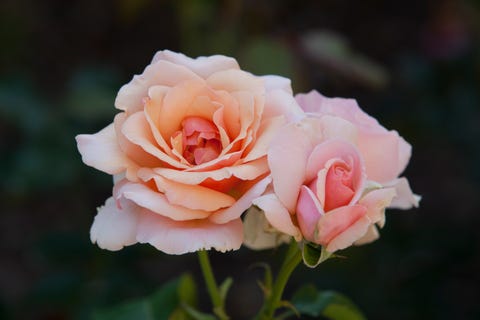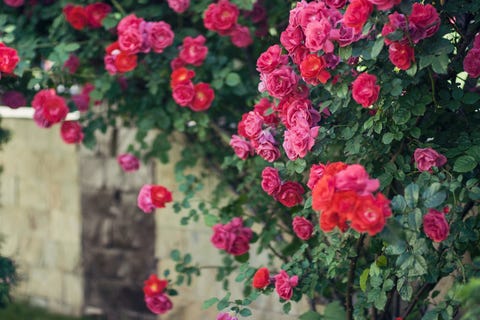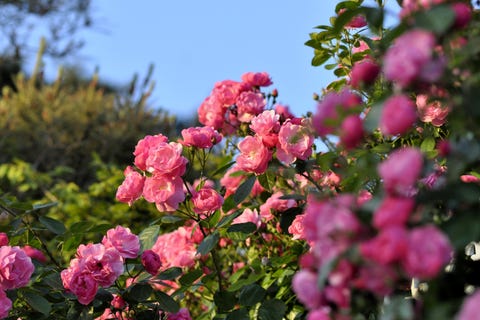Kissy Kissy Baby Girls Garden Roses Print Convertible Gown
No flower is more recognizable or universally loved than the romantic rose. The word itself evokes images of manicured English gardens or charming cottages covered with climbing vines. But roses look beautiful in any garden setting, and, honestly, they're less fussy than you think! "Many people believe they're too much work to grow, but newer varieties are more disease-resistant and deadhead themselves so you don't have to prune," says Layci Gragnani, rose program manager for Star Roses and Plants. "You can do as little or as much work as you like with modern roses and have success."

Deanna Kelly Getty Images
The general care for any rose is the same, no matter what type. First, read the label to make sure it will survive in your USDA hardiness zone (check yours here). Choose a planting spot with full sun, at least 6 hours per day. Then dig a hole about 2 to 3 times the size of the pot, and set the plant in the hole at the same level it is in the pot. Water well, then every other day as needed. The soil should feel damp (not soggy!) and not be allowed to dry out completely as the plant is getting established. Add mulch to retain moisture and suppress weeds. Feed your rose with a balanced slow-release fertilizer following package instructions, but stop by mid-summer so it can prepare itself for dormancy in the fall, says Gragnani.
When it comes to what type to buy, you've tons of options. The American Rose Society classifies roses into different categories, including species, or wild, roses and Old Garden Roses, which are those that were in existence before 1867. Modern roses, those developed after 1867, are what most people grow nowadays. They fall into three basic categories: hybrid tea roses, shrub roses, and climbing roses. Here's what you should know about each one of these delightful types of roses:
Hybrid tea rose
Hybrid tea roses typically have a a spiral-petaled appearance with a large, lush bloom. They're often grown for cutting and display in vases, says Gragnani. Generally, they're also extremely fragrant. There's typically one bloom per stem, and the plants range from about 48" tall by 36" wide.
Most important qualities: long stems for cutting and fragrance

Yulia Shaihudinova Getty Images
Climbing rose
Climbing roses have long branches, called canes, that can grow up to 12 feet long. The flowers come in many shapes and forms, both double or single-petaled. They can be trained to grow up a trellis, arbor, or fence by securing the canes to the structure using stretchy garden tape that gives as the plant grows, says Gragnani.
Most important quality: can be trained up a structure for a stunning effect

Youngjean Kim / EyeEm Getty Images
Shrub or landscape rose
Shrub roses, also called landscape roses, are just what they sound like: a shrubby form that's hardy in most climates. This category is subdivided into floribunda and grandiflora. "The only difference is that floribunda is a smaller shrub," says Gragnani. They are available in every color of the rainbow and have multiple blooms on each stem. Floribundas range from 24" tall to 36" wide. Grandifloras are about 36" tall and 48" wide.
Most important qualities: hardiness and tons of flower power
Beautiful Roses for Your Garden

Cherry Frost™ Climbing Rose

Coral Rose Shrub Rose
amazon.com

Chicago Peace Hybrid Tea Rose

Oso Easy Italian Ice Rose
Follow House Beautiful on Instagram.
Arricca Elin Sansone Arricca SanSone has written about health and lifestyle topics for Prevention, Country Living, Woman's Day, and more.
This content is created and maintained by a third party, and imported onto this page to help users provide their email addresses. You may be able to find more information about this and similar content at piano.io
Kissy Kissy Baby Girls Garden Roses Print Convertible Gown
Source: https://www.housebeautiful.com/lifestyle/gardening/a31857692/types-of-roses/
0 Response to "Kissy Kissy Baby Girls Garden Roses Print Convertible Gown"
Enviar um comentário